Key takeaways:
- JavaScript frameworks streamline development and enhance user experience, allowing for efficient and organized coding through reusable components.
- Choosing the right framework involves considering project needs, learning curves, and long-term community support, which can greatly impact the development process.
- Learning JavaScript comes with challenges; perseverance and community support can turn obstacles into valuable learning experiences.
- Future goals in JavaScript include mastering emerging technologies and contributing to the open-source community to enhance development capabilities.
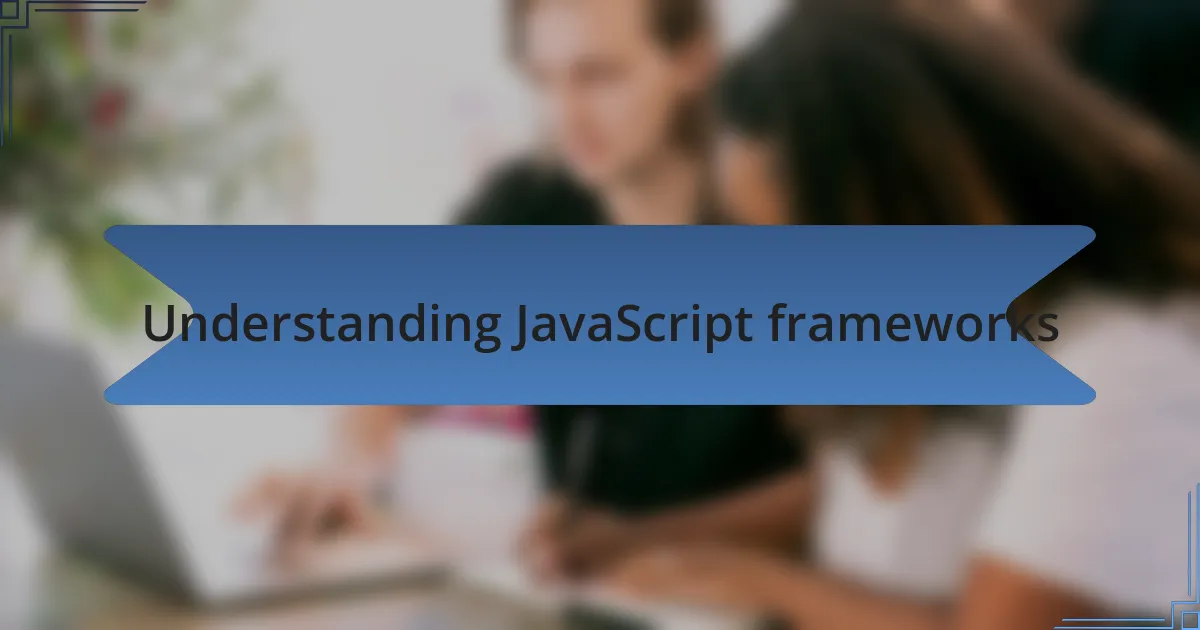
Understanding JavaScript frameworks
Understanding JavaScript frameworks goes beyond just picking one and using it; it’s about grasping the philosophy and structure behind them. I remember when I first encountered frameworks like React and Angular. At first, the concepts felt overwhelming, like trying to assemble a puzzle with missing pieces. But once I started to understand how they streamline development and enhance user experience, the entire landscape of web development shifted in front of me.
Each framework has unique features tailored to solve specific problems. For example, React’s component-based architecture allows for reusable UI elements, making my coding process feel more efficient and organized. Did you ever wonder how much time could be saved by reusing components rather than building everything from scratch? That insight transformed how I approached projects, leading to cleaner code and happier clients.
Dive a bit deeper, and you’ll find that JavaScript frameworks often come with a steep learning curve, but the payoff is significant. I recall painstaking nights trying to grasp concepts like state management and routing. It was challenging, yet those struggles created a stellar foundation for my development skills. Understanding these frameworks not only boosts productivity but also opens doors to powerful features that can elevate your projects—so why not take the plunge and see how they can change your development journey?
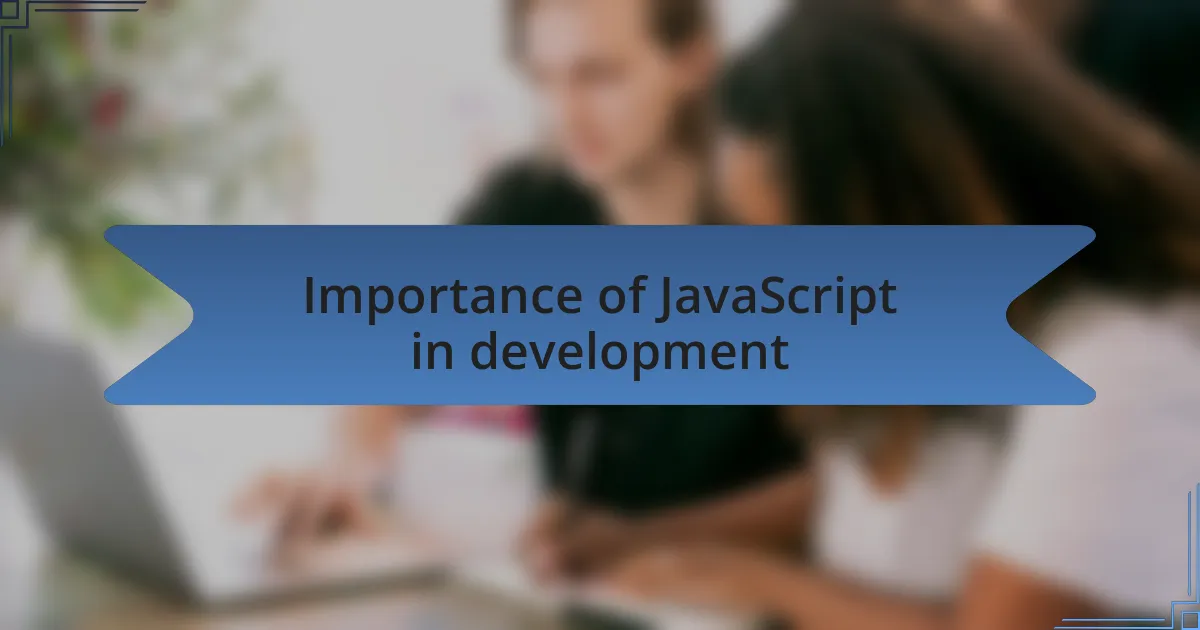
Importance of JavaScript in development
JavaScript’s role in web development is paramount, serving as the backbone of modern web applications. I remember tackling a project where the JavaScript functionality truly brought the site to life; the interactive elements I could implement made all the difference. Can you imagine a website without the seamless interactivity that JavaScript provides? It’s like trying to navigate a vibrant city without any roads—frustrating and impossible.
Moreover, JavaScript’s ability to run in any browser creates a level playing field for developers. This universal nature was a game changer for me when I transitioned from back-end development to full-stack. Suddenly, I realized I could leverage JavaScript for both server-side and client-side programming, making it easier to understand the flow of data and user interactions. How often have you found yourself battling compatibility issues? With JavaScript, that concern is significantly minimized.
Lastly, as more frameworks and libraries emerge, JavaScript continues to evolve, pushing the boundaries of what we can build. I recall diving into Node.js for a backend project, and the experience was eye-opening. The fact that I could use the same language on both the front-end and back-end felt remarkably efficient and empowering. It’s thrilling to see how this adaptability positions JavaScript at the forefront of development, don’t you think?
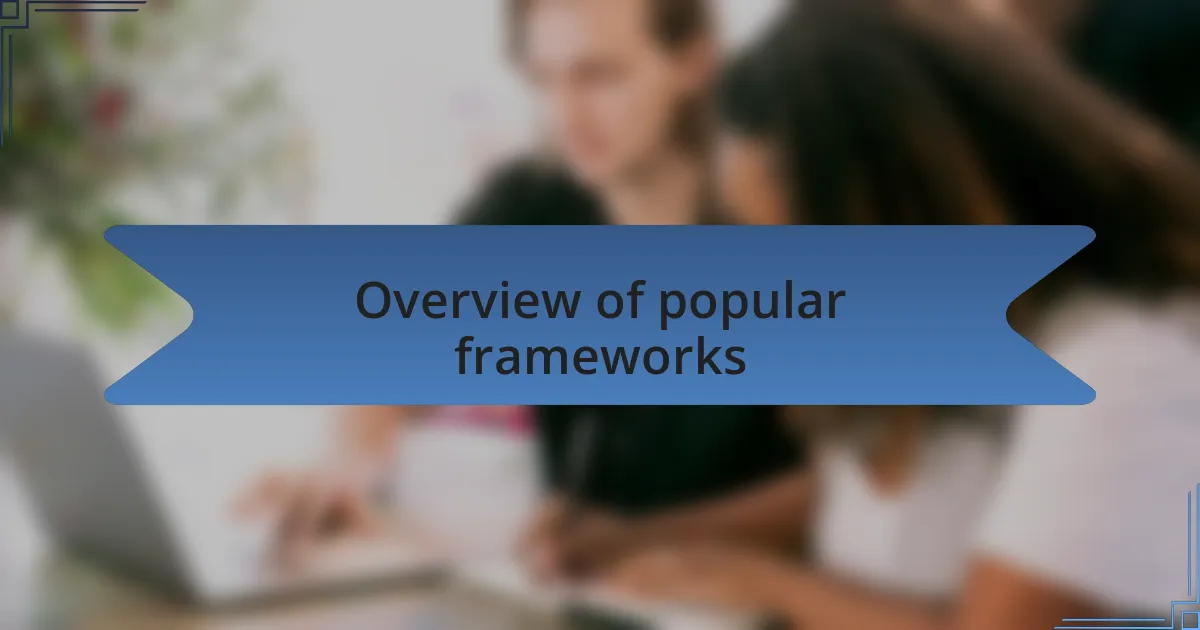
Overview of popular frameworks
When exploring popular JavaScript frameworks, I often think about React, Angular, and Vue.js as the big players in the field. For instance, I was initially drawn to React because of its component-based architecture, which made building user interfaces feel surprisingly straightforward. Have you ever tried to break down a complex project into manageable pieces? That’s the beauty of React—it allows you to think in components, which can drastically simplify development.
Angular, on the other hand, intimidated me at first with its complexity, but I soon realized its power once I grew comfortable with it. I vividly recall a project where its two-way data binding saved me countless hours of coding. It’s fascinating how a robust framework can handle intricate data dynamics without breaking a sweat. Have you experienced similar moments where a tool exceeded your expectations?
Then there’s Vue.js, which felt like a warm embrace after working with other frameworks. Its flexibility and ease of integration astounded me, especially when I integrated it into a smaller project. I appreciate how it allows me to gradually adopt features, making it less overwhelming. Doesn’t it feel great when a framework serves your needs without imposing too much complexity? This flexibility is one of the reasons Vue.js is gaining traction among developers like me.
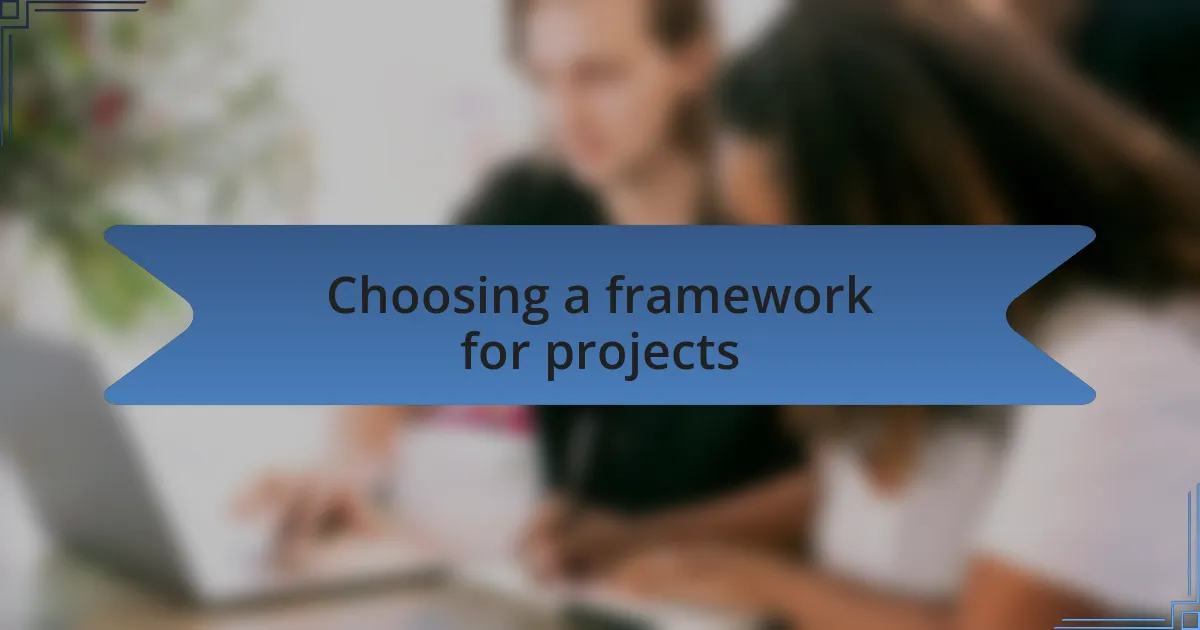
Choosing a framework for projects
When faced with the task of choosing a framework for a project, I often reflect on the project’s specific needs. For example, during a team project where real-time data updates were essential, we chose Angular because its powerful two-way data binding really fit the bill. Have you ever chosen a tool based on a particular feature, only to realize later that it was the perfect match for your requirements?
I can’t stress enough how important it is to consider the learning curve associated with each framework. I remember diving into Vue.js without much prior experience, and while it felt initially daunting, the approachable documentation and community support made the transition smoother than I anticipated. Have you ever started a new framework thinking it would be an uphill battle, only to find it wasn’t as hard as you thought?
It’s essential to weigh the long-term implications of your choice as well. I learned this the hard way when I opted for a lesser-known framework for a pet project; while it was fun at first, I quickly found myself struggling with limited resources and community engagement. Doesn’t it make sense to choose a framework that not only meets your current needs but is also supported by a vibrant ecosystem? Recognizing the importance of community can save you significant headaches down the road.
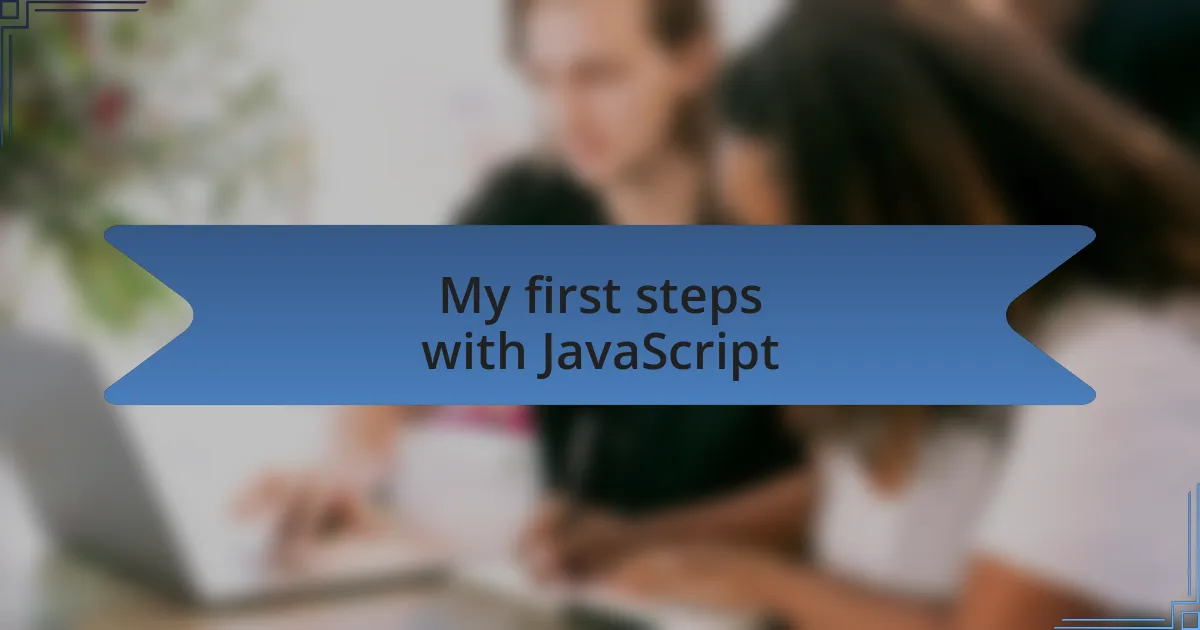
My first steps with JavaScript
My journey with JavaScript began on a rainy afternoon when I awkwardly typed my first “Hello World” program. The thrill of seeing that simple text render on the screen was electric. I still remember the sense of accomplishment it ignited within me. Have you ever experienced that moment when you realize you’ve unlocked a new skill, and it feels like the possibilities are endless?
As I explored further, I dabbled in manipulating the Document Object Model (DOM), and it was like playing with digital clay. I recall a particular instance when I created a small interactive webpage that responded to user clicks and inputs. The joy of seeing users engage with something I created was profound. Didn’t you ever feel that rush when your code works and brings an idea to life in front of your eyes?
Eventually, my curiosity led me to delve into JavaScript frameworks, but that leap felt intimidating at first. I vividly recall spending hours in front of the computer, poring over documentation, trying to grasp the fundamentals of React and its component-based architecture. Looking back, those initial struggles shaped my understanding and resilience. Isn’t it fascinating how those early challenges can be the building blocks for greater achievements down the road?
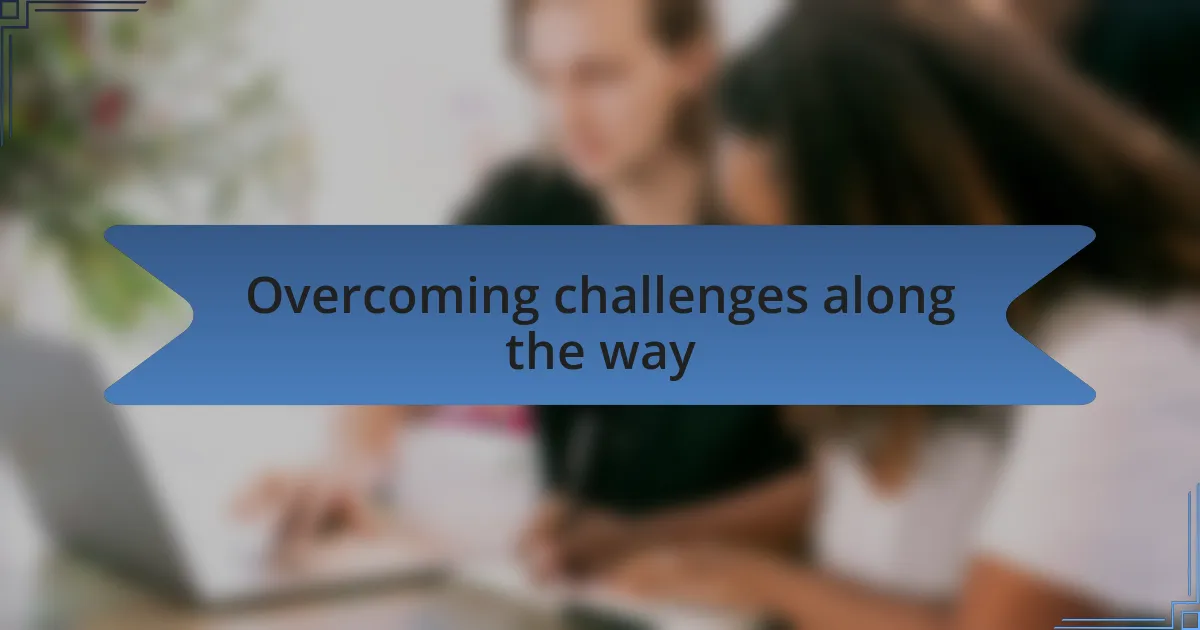
Overcoming challenges along the way
As I immersed myself in learning JavaScript frameworks, I encountered a roadblock that initially felt insurmountable. There were days when I stared at error messages, baffled and frustrated, questioning my decision to venture into this complex world. I remember one specific evening when I couldn’t resolve a stubborn issue with my utility function. It was disheartening, but in those moments, I learned the true value of perseverance. Hasn’t everyone had one of those nights where you just want to throw in the towel?
One turning point for me was realizing that community resources could be a lifeline. I discovered forums and online groups where developers shared their struggles and solutions. I remember reaching out for help on a particularly tricky bug in my application. The response was swift and supportive, and it made me feel less isolated in my journey. Isn’t it amazing how collaboration can turn a challenge into an opportunity for growth?
Eventually, I learned that failure is a stepping stone rather than a barrier. Every misstep and failed attempt provided me with invaluable lessons. I vividly recall a project I confidently thought would be smooth sailing, only to be met with unexpected hurdles. But these experiences ultimately armed me with skills and insights that will serve me well in future endeavors. Have you ever noticed how overcoming setbacks can deepen your understanding and fuel your determination?
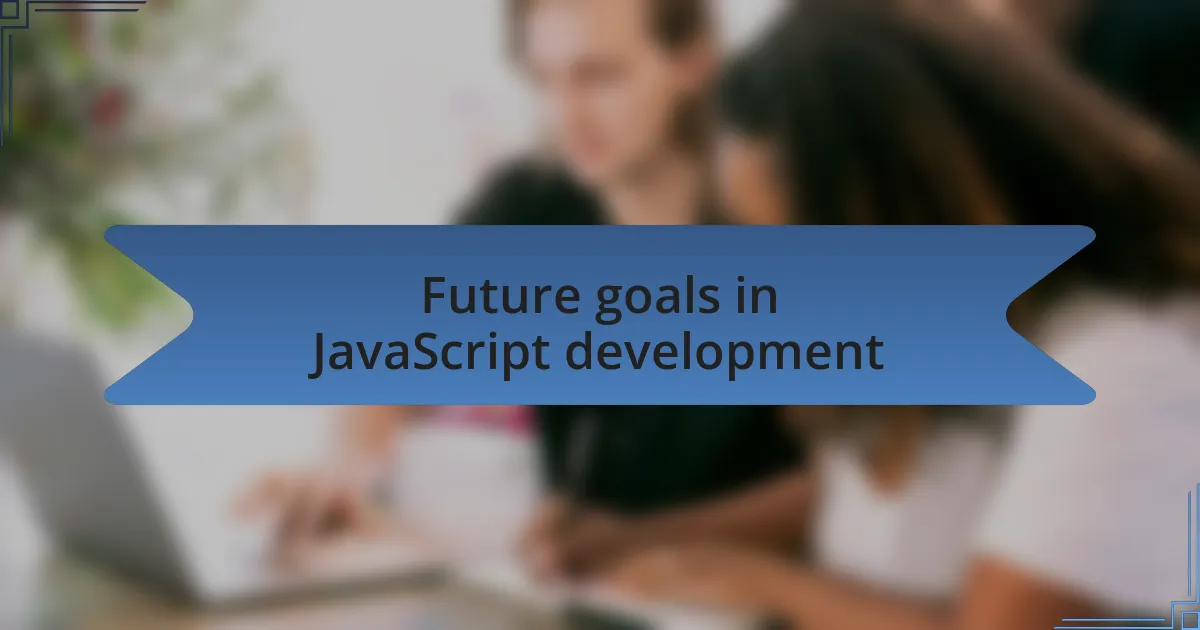
Future goals in JavaScript development
As I look toward the future in JavaScript development, my primary goal is to deepen my understanding of emerging technologies like server-side rendering and static site generation. Recently, I stumbled upon a project that utilized Next.js for building highly performant applications. I was captivated by how effortlessly it managed routing and data fetching. Have you ever experienced that moment when a tool completely shifts your perspective?
Another aspiration of mine is to master the integration of JavaScript with APIs, particularly in the realm of real-time data. I vividly recall working on a project that required live updates; the thrill of seeing my code come to life in real time was exhilarating. It made me realize how essential it is to harness these capabilities for dynamic applications. Isn’t it fascinating how the right integrations can elevate user experiences to new heights?
Lastly, I aim to contribute more to the open-source community. A few months back, I participated in an initiative that enhanced an existing library. The sense of camaraderie and shared achievement was uplifting. I often wonder, how can sharing our skills and insights shape the future landscape of development? I believe that by collaborating and giving back, we collectively push the boundaries of what’s possible with JavaScript.